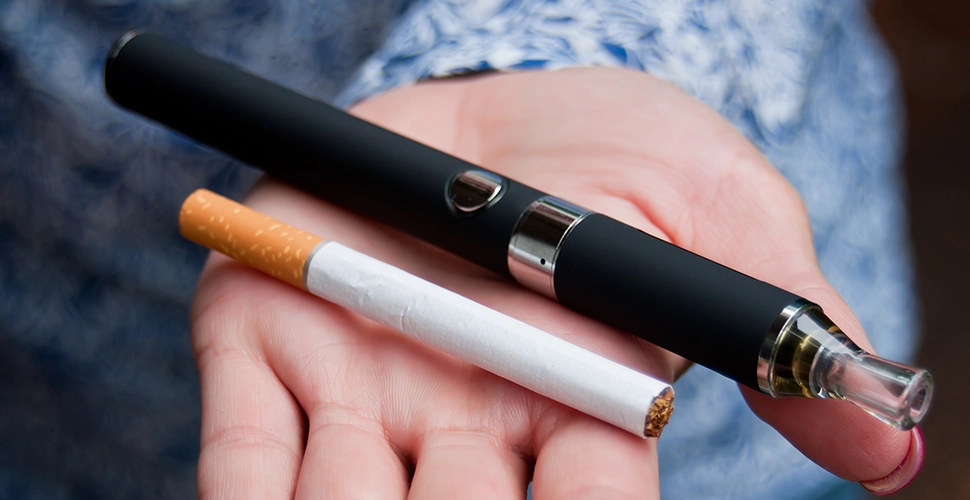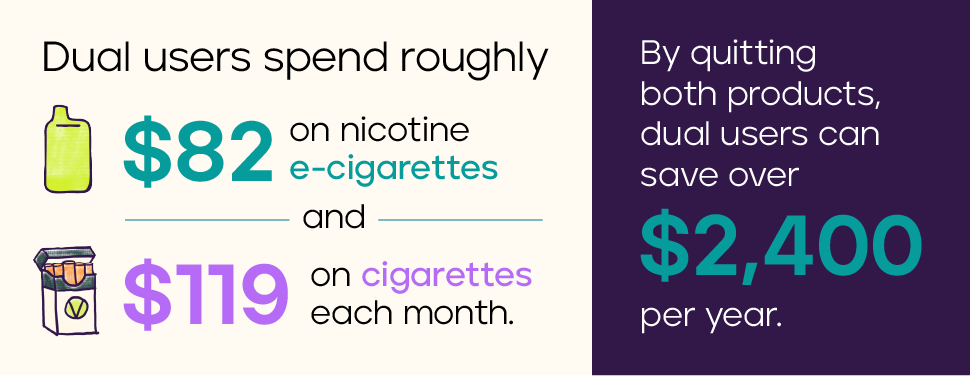When people smoke and vape at the same time (called dual use), do they face increased health and financial risks? The answer is yes, but they aren’t the only ones who feel the pinch. Dual users can produce even more costly tobacco-related illnesses for your organization.
However, you can reduce this financial burden—for your organization and your people—by offering tailored quit resources that help people quit multiple tobacco products at the same time.
How many people smoke and vape in tandem?
Roughly 2 million U.S. adults are dual cigarette and e-cigarette users. Rates of dual use are especially high among people who primarily vape, with 39% of current e-cigarette users also smoking.
Although some users who smoke and vape might think dual use can help them quit one or both products, dual use is actually associated with higher nicotine dependence, which can make it harder to quit.
As a result, dual users may need additional resources and support compared to people who only use one nicotine product.
Member posts in our online EX Community reinforce just how hard quitting two tobacco products can be.
EX Program user asalata1990 shared: “I’ve smoked cigarettes for almost 18 years and started vaping about 6 months ago. I thought that vaping would be better because it smells less and is significantly cheaper. While that’s true, I’m here to say that quitting vaping was much more difficult, by a long shot. Quitting vaping has, by far, been the most difficult thing I have ever overcome.”
Likewise, EX Program user Bask posted: “I’ve been smoking for about 8 years and l started vaping 2 years ago to quit smoking. Instead, I started using both. I noticed that I was more addicted to vaping than smoking and decided to quit both 10 days ago. It has been really hard for me the first few days…”
Health impact of dual use
Dual use can pose health risks comparable to or potentially higher than exclusive smoking, with increased odds of several diseases and health conditions, including:
- Cardiovascular disease: Dual users have been found to have significantly higher odds of cardiovascular disease compared to those who smoke cigarettes but have never vaped.
- Respiratory issues: Some studies suggest that dual use may be associated with a higher risk of asthma and chronic obstructive pulmonary disease (COPD) compared to exclusive cigarette use.
Financial impact of joint smoking and vaping
People who smoke and vape can also suffer a financial impact.
Buying both smoke and vape products can take a toll on someone’s monthly budget. Dual users spend roughly $82 on nicotine e-cigarettes and $119 on cigarettes each month. By quitting both products, dual users can save over $2,400 per year.
Helping people quit smoking and vaping can reduce your organization’s financial burden, too. Annual U.S. healthcare expenditures attributable to adult dual tobacco use total $13.8 billion.
Why do people smoke and vape at the same time?
There are many reasons why people might smoke and vape at the same time. Some start vaping to cut back on cigarette smoking, to cope with nicotine withdrawal, or to reduce secondhand smoke.
Situational factors may also play a role. For example, someone may use an e-cigarette as their primary device but smoke cigarettes in social contexts where others are smoking. Likewise, people who smoke may switch to vaping to continue using nicotine in spaces where smoking is prohibited.
Tailored resources can help people quit both
Switching to e-cigarettes may be helpful for some to quit cigarette smoking; however, continued vaping can lead to a higher risk of smoking relapse.
To minimize health risks and relapses, people who smoke and vape should aim to quit both products.
EX Program provides tailored support for dual users via web content, text messaging, and EX Coaches via live chat that can help individuals quit nicotine for good.
EX Program users can also access the nation’s most established online quitting community, where people can connect with other quitters about dual use, and read blogs with expert guidance from Mayo Clinic specialists.
To see more about how EX Program helps individuals overcome dual use—and all forms of nicotine—please contact us today.






